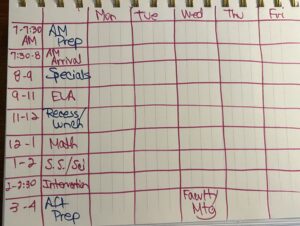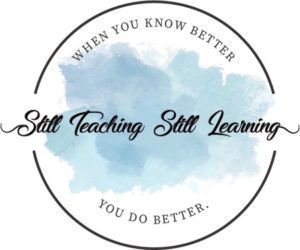
Teachers have many demands on their time. One of the most critical parts of the job is planning and preparing for teaching.
Unfortunately, sometimes that time dwindles as you work on completing all the other tasks that come up and seem more urgent.
This post will give you some quick tips for blocking out time for the necessary planning and prep while also blocking out time to complete the other required tasks.

First, we’ll use time blocking to structure your weekly to-do lists.
Time Blocking in 4 Steps
1 – To do this, start by reviewing your weekly and daily schedule and identifying the blocks of time you have to complete prep and planning work.
Here’s this might look for me. (The navy blue blocks are times when tasks could be completed.)

2 – Create a giant brain dump list of everything you need to do every week, and when I say everything, I mean every little part of the task.
For example, lesson planning for ELA involves lots of smaller parts. It might include planning your whole group lessons, choosing whole group text, prepping that text for each day’s lessons (what you will do, what your students will do, what questions you will ask), and planning the students’ independent assignment.
It might also involve planning for several different small group lessons differentiated for your students’ needs. That may also involve selecting texts, prepping that text for the day’s lessons, and planning assignments.

You will also need to list locating the texts if those are not provided for you.
Then you will need to list the assessments you will do along with time to grade the assessments and possibly upload grades to an online platform.
Whew! And that’s just one subject! This may sound tedious (and it is), but it helps identify the different tasks so that you can plan to do certain tasks at one time in your day or week and other tasks at other times.

3 – Put time estimates next to each task. If you’re not sure, err on the generous side and estimate more time than you think you will need.
4 – Indicate how often you want to do the tasks. Daily, weekly, twice a week, monthly?
Now, let’s batch those tasks and plan when to finish them.

Task Batching in 2 Steps
Task batching organizes our to-do lists by grouping similar tasks and completing them in identified time blocks.
There are many ways that task batching helps make you more productive. Every time we switch tasks, our brains have to reset, which takes time and energy. When we batch our tasks, we group tasks that have the same “cognitive load” or the same demands on our working memory.
Doing all the same types of tasks at a designated time cuts down on distractions and helps make us more efficient.

Here are some examples of cognitive load categories: creative, decision-making, logistics, and quick tasks.
Creative tasks might include lesson planning and writing (report card comments, newsletters, parent emails).
Decision-making tasks might include grading and analyzing assessments.
Logistics might include making copies, completing paperwork, and changing anchor charts on the board or wall.
Quick tasks are anything that doesn’t require brainpower and can be completed in 15 minutes or less. (These might even be good tasks to get your students to do for you or turn them over to parent volunteers or teacher assistants.)

Now – back to that giant brain dump of tasks.
1 – You’ve got your task list, time estimates, and how frequently the tasks should be completed. Now identify what kind of cognitive load the tasks need.
If it’s a creative task that requires your thoughts and full attention, put a “C” beside it.
If the task needs your focus for decision-making, put a “D” beside it.
Logistics tasks get an “L.”
Quick tasks get a “Q.”

2 – Go back to your daily/weekly schedule with the identified blocks of time to work.
Plug your creative tasks into blocks of time when you have more time (15 minutes is probably not enough) and when you have the energy to focus on them.
Decision-making tasks can be plugged into smaller chunks of time, but still need a time of day when you can focus.
The logistics tasks and quick tasks can be plugged into the remaining time. (And remember – the quick tasks might be tasks you can delegate so you won’t have to do them!)
Now let’s look at how we can structure a weekly schedule.

Weekly Schedule
This can be structured according to your best work times, but here are some principles.
*Plan your lessons earlier in the week (Monday and Tuesday), then reserve Wednesday, Thursday, and Friday for the logistical details related to those lesson plans (collecting resources or making copies, for example).
*Speaking of resources and copies – it’s helpful to have storage drawers for keeping all materials organized for the days when you will need them.
*Do your decision-making grading work on one day, then enter grades online on another day.

*Some teachers keep their faculty meeting days open for logistical and quick tasks.
*Consider keeping one day unscheduled so you can complete anything that was not completed on its scheduled day.
*Instead of taking time to put materials away, you might use a dishpan or crate to hold all those materials. Then spend one day’s logistical task time to return the materials.

*Check email at designated times, preferably only two times a day.
*Any time you complete all your tasks for one day, get started on the next day’s tasks! (It might not happen often, but it’s awesome when it does happen.)
*Once you have a weekly task list system that works for you, consider making a daily checklist. Then, you can check off the work as you complete it.

For more tips on creating a schedule for your before and after school work times, check out my course, The Teacher’s Guide to Using Before and After School Time Effectively! I’ll walk you through setting up your task schedule step by step.
All of my content is intended to save teachers time and energy. My goal is to make good teaching sustainable while having a life outside of teaching. Let me know how I can help YOU with this quick form!
